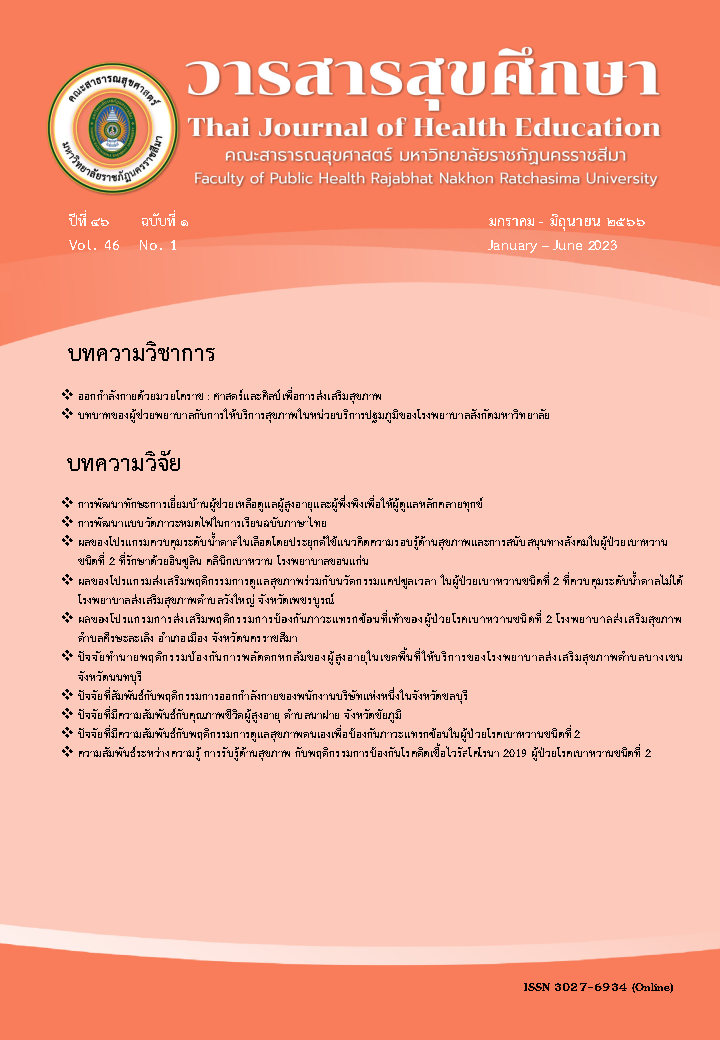Factors Related to The Physical Exercise Behavior of Company Employees, Chon Buri Province
Main Article Content
Abstract
Physical exercise is significant for health promotion. This study was a cross-sectional survey -aiming to study the factors related to physical exercise among the employees of a company in Chon Buri Province.The samples were 396 employees of the company selected by stratified sampling. Data collection was conducted using an online questionnaire. The data was analyzed by the following statistical methods: frequency, percentage, and chi-square statistics. and the Pearson correlation coefficient was used to analyze the factors related to exercise behavior.
The results found that most of the samples (61.1% of males and 38.9% of females) 45.5 percent of the samples had a body mass index of 37.6 percent at level 1 obesity. Most of the participants (74.0%) did not have concomitant diseases, while 26.0% did. Regarding the factors related to physical exercise, it was found that the demographic factors, including gender and body mass index, were significantly related to physical exercise (X2= 22.197, p=0.048 and X2= 1.823, p=0.049 respectively). Regarding predisposing factors, it was found that self-efficacy was significantly related to physical exercise (r=0.829, p<0.001), For the enabling factor, access to information about physical exercise and physical exercise behavior was found to correlate significantly with physical exercise (r=0.530, p<0.001). Regarding the reinforcing factor, support received about physical exercise was found to correlate significantly with physical exercise (r=0.696, p<0.001). Suggestions from the research findings that enterprises and related agencies should organize activities to promote self-efficacy on physical exercise, health information support and support for healthy exercise activities for employees in order to have good health and be able to work efficiently.
Article Details

This work is licensed under a Creative Commons Attribution-NonCommercial-NoDerivatives 4.0 International License.
References
กองเศรษฐกิจการแรงงาน สำนักงานปลัดกระทรวงแรงงาน. สถานการณ์ด้านแรงงานรายปี 2563. กรุงเทพมหานคร: กระทรวงแรงงาน; 2564:1-5.
สำนักงานสถิติแห่งชาติ. สถานการณ์ปัญหาสุขภาพประชากรและพฤติกรรมที่เกี่ยวข้องกับประชากรวัยทำงาน[อินเทอร์เน็ต]2566. [เข้าถึงเมื่อ 15 พฤษภาคม 2566]. จาก https://dopah.anamai.moph.go.th/webupload/8x6b2a6a0c1fbe85a9c274e6419fdd6071/tinymce/KPI2564/KPI119/25640111925.pdf
Green, I.W., Kreuter M, W.Health program planning: An educational and ecological approach. 4thed. New York: Emily Barrosse; 1998.
มณีรัตน์ ธีระวิวัฒน์ และนิรัตน์ อิมานี. การวางแผนงานโครงการสุขศึกษาและส่งเสริมสุขภาพ. พิมพ์ครั้งที่ 1. นครปฐม: เพชรเกษม พริ้นติ้ง กรุ๊ป; 2556.
Daniel, W. W. Biostatistics: A Foundation for Analysis in the Health Sciences, 11th Edition. 1-720. Hoboken, New Jersey: John Wiley & Sons; 2018.
Bloom, B. S. Taxonomy of Educational Objectives: Handbook 1, Cognitive Domain. New York: Mackay; 1972.
Cronbach, L. Essential of Psychological Testing. (4th ed.). New York: Harper; 1984.
กัลวัฒน์ มัญชะสิงห์. การวิเคราะห์สหสัมพันธ์ (Correlation Analysis). [อินเทอร์เน็ต]2557. [เข้าถึงเมื่อ 24 กันยายน 2565]. จาก http://kalawatblog.blogspot.com/2014/07/correlation-analysis.html
รัตน์กัมพลชัย อิ้วสวัสดิ์. ปัจจัยที่มีความสัมพันธ์กับพฤติกรรมการออกกำลังกายของบุคลากร สังกัดเทศบาลตำบล อำเภอพุทธมณฑล จังหวัดนครปฐม. 2559.
Bandura, Albert. Self-efficacy: Social Learning Theory. New Jersey: Prentice-Hall; 1977
อโนทัย ผลิตนนท์เกียรติ และคณะ. ปัจจัยที่มีความสัมพันธ์ต่อพฤติกรรมการออกกำลังกายของนักศึกษา กายภาพบำบัด มหาวิทยาลัยหัว-เฉียวเฉลิมพระเกียรติ. วารสารมหาวิทยาลัยหัวเฉียวเฉลิมพระเกียรติวิชาการ, 2561;42:55-64.
ธนพร แย้มศรี, ชนัญขิดาดุษฎี ทูลศิริ และยุวดี ลีลัคนาวีระ. ปัจจัยทำนายพฤติกรรมการออกกำลังกายของนักศึกษาพยาบาล วิทยาลัยบรมราชชนนี เครือข่ายภาคตะวันออกเฉียงเหนือ. วารสารพยาบาลและการดูแลสุขภาพ, 2560;2:158-168.


